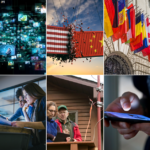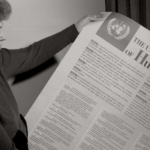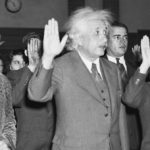Seven decades ago on this day, the world came together to adopt the Universal Declaration of Human Rights. Eleanor Roosevelt, who led much of the work to craft the declaration, called it a “Magna Carta for all mankind.” As she hoped, it remains an important document that has stood the test of time, in large measure because of the timeless values it protects. Today’s anniversary provides a moment for reflection around the world. From our vantage point at Microsoft, part of this reflection should include the role of technology, both in its impact on human rights in the past and even more for its role in the future.
The governments that assembled to approve the declaration in December 1948 had been brought together in part by the impact of technology. It had been a tragic journey. As Albert Einstein was among the first to recognize in the 1930s, the “achievements of the machine age” had created new dangers for humanity, especially as human institutions failed to keep pace with technology itself. By 1948, Einstein’s words were no longer a prophetic warning about the future. They had become part of the history of a global war in which advanced weapons had claimed more than 60 million lives.
That shared experience left the world’s leaders with a strong commitment not only to keep the peace, but to protect fundamental rights. As they declared, the “disregard and contempt for human rights” had led to “barbarous acts” that had outraged the conscience of people everywhere. This had led to a new resolve, embodied in the Universal Declaration, to pursue a future in which people could “enjoy freedom of speech and belief and freedom from fear and want,” proclaiming these “as the highest aspiration of the common people.”
As with all international norms and laws, the declaration wasn’t a panacea for the world’s ills. The decades following its adoption weren’t always kind. The world still witnessed oppressive and even genocidal movements afflicting the generations of our own time. But thanks in part to the Universal Declaration and the courageous work of repeated United Nations High Commissioners for Human Rights, the past seven decades have proved better for human rights than the years that preceded them.
More recent decades have also witnessed an explosion of information technology that has profoundly impacted human rights around the world in both good ways and bad. Communications technologies from the fax machine to word processing software to the internet have enabled people to connect with each other, learn about the world’s developments and express themselves in new ways. One of the world’s ubiquitous tools is our own Microsoft Word. Many days Word is used by dedicated writers to advance the world’s highest aspirations. But no doubt there are darker days when less high-minded actors use it for writings that are far less noble. As Einstein had in effect warned the world, in the wrong hands every tool can become a weapon. And just as in the 1930s, that is a sobering reminder for the information technology of today’s future, which is assisting people with far more than their writing.
We should use today’s anniversary to reflect on the role technology can and should play in advancing human rights in the future. This calls on us to think about three things.
First, it’s as important as ever to address clear-eyed and head-on the risks that technology poses for human rights. Digital technology has become a cornerstone of virtually every part of our societies’ and personal lives. This makes it critical, for example, to come together to address spreading cyberthreats, whether in the form of indiscriminate cyberstrikes like those witnessed last year, or nation-state disinformation campaigns against electoral processes that are a cornerstone of the Universal Declaration’s protections. It’s also why we need to remain vigilant in protecting the privacy of people’s personal information and proactive in addressing the risks that can come from even beneficial new technologies such as facial recognition and other forms of artificial intelligence, or AI. History teaches us that risks for human rights rise not only when harmful actors use technology for dangerous pursuits, but when good people fail to think ahead or rally to act together. Seven decades after the Universal Declaration’s approval, the defense of human rights requires that those close to technology exercise constant thought and even courage.
Second, on a brighter note, technology has become a powerful tool for protecting human rights. As we’ve found in our own partnership with the United Nations Human Rights Office, new technology can help to better predict, analyze and respond to critical human rights situations around the world. But that’s just the beginning. In the hands of important nongovernment organizations, new AI-based technologies can equip and empower human rights experts and volunteers to address abuses on the ground and bring them to the world’s attention.
That’s part of why we launched in September our AI for Humanitarian Action program, to which we’ve committed $40 million over the next five years to provide human rights groups with technology, expertise and financial resources to take their work into the future.
Finally, the protection of people in the 21st century requires new forms of multi-stakeholder action, including to addressing the intersection between technology and human rights. The approval of the Universal Declaration seven decades ago involved a United Nations vote with assent from 48 governments. While governmental action remains as vital as ever, it has become more important, especially in the technology space, to bring together a broader group of stakeholders. This has been one of the fundamental advances forged by the Global Network Initiative, which has worked for a decade to bring together human rights groups with tech companies. Similar forward-looking efforts were on display last month in the same city where the United Nations approved the Universal Declaration. More governments have now come together to sign the Paris Call for Trust and Security in Cyberspace than voted initially to approve the Universal Declaration. But this time, they were joined by a broad multi-stakeholder group that now includes roughly 400 companies, associations and nongovernmental organizations from around the world.
On a day that marks an anniversary of 70 years, we need to recommit ourselves to the hard work needed to address proactively and thoughtfully the thorny issues that connect human rights with technology. We need to make this more than a day to commemorate the past. It needs to be a day that moves toward a brighter future.









